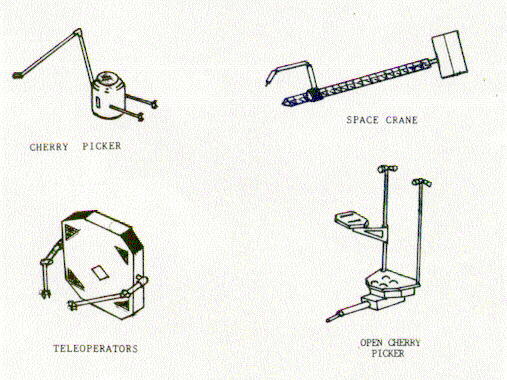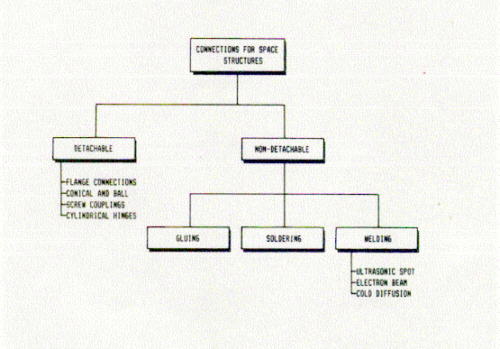|
astrotectonics:
an overview of non-terrestrial construction
By: Thomas M. Ciesla
page 3 of 5
Orbital Facililty Construction: Support Equipment
To accomplish the assembly of large structures in LEO and beyond, astroworkers must depend on an array of supprt equipment. Development studies have produced po=rototypes and operational techniques for a number of categories, such as : space crane (Gunkel, R.J. et.al. 1978); telerobotic manipulators (Gvamichaca, A.S. and Koshelev, V.A. 1984; Greely, R. and Williams, R.J. 1987; Matsumoto, K. et.al. 1986; Nagatomo, K. et.al. 1985); holding fixtures (Gould, C.C. 1981; Katz, E and Roebuck J.A. 1981); manned remote workstations (Nathan, C.A. 1978, Nassiff, J.A. 1978); and spacesuit development for extended extra-vehicular activities - EVA's (32,33).
The space-suited astroworker, floating amongst the structural framework of orbital facilities will remain a familiar sight for decades to come. Rather than replacing man in space, this support equipment will aid him in thre distinct ways: (1) provide greater torques and larger forces at greater reaches, (2) provide stability to a structure to prevent tumbling about one or more axis, (3) replace man during periods of high radiation flux. The use of these remotely operated cranes and manipulators will bring about the formation of a new class of astroworker -- the teleoperator technician -- skilled in operatiing cranes, cherry pickers or manipulators from a remote location in the Space Station or he Shuttle; or from a remote workstation of a construction platform. Data from a sophisticated system of video, lighting and instrumentation will be all the feedback the operator will have to control activities that may be a kilometer away.

Figure 2 Orbital Support Equipment
Connection designs for trusswork systems used on space platforms are an important element of overall assembly time for orbital projects. The use of a hub spar and strut system similar to the Star Bay System (Bak, D.J. 1987; Covault, C. 1987), is a likely candidate for the Space Station. This "push and lock" type of connection lessens hand fatigue for the astroworker and is easily worked by remote manipulators. Larger structures will require the use of detachable and non-detachable connections, such as a combination of hub-and-strut system with welded or soldered joints.

Figure 4. Connections For Space Structures
|